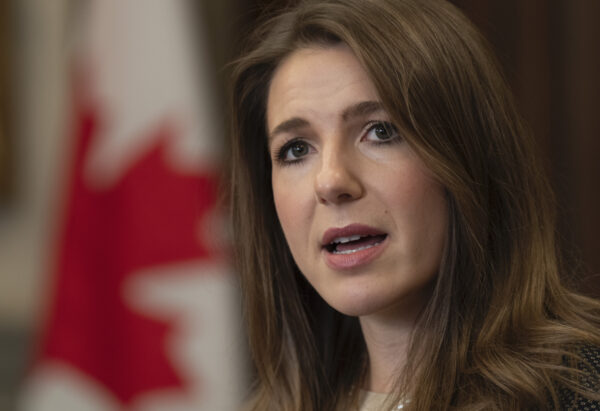Ottawa Didn’t Disclose China’s Spy Balloon Because There Were ‘Lives at Stake,’ Minister Says
Public Safety Minister Marco Mendicino says Ottawa didn’t tell the public about China’s spy balloon that was spotted over North America because there were “lives at stake.” “There are lives at stake. There are techniques at stake. This is complex stuff,” Mendicino told the Canada-China House of Commons committee on Feb. 6. Mendicino was being challenged by Conservative public safety critic Raquel Dancho on why the Canadian public didn’t learn about the balloon from the federal government, raising concerns about transparency. “Canadians actually found out about the spy balloon that was over Canadian sovereignty for several days not from your government, not from a Canadian news agency, but from an American one. Do you find that acceptable?” Dancho said. Conservative Party Public Safety critic Raquel Dancho speaks with reporters in the foyer of the House of Commons, in Ottawa, Oct. 21, 2022. (The Canadian Press/Adrian Wyld) Mendicino said the government needs to be cautious about releasing information so it doesn’t jeopardize any national security operation, “as well as the people who are engaged in those operations.” “That is a matter of the utmost sensitivity,” he said. Dancho retorted that the U.S. government would have the same consideration, but it still shared the information. Mendicino’s reply centred around Canada and the United States collaborating in response to the incident. Dancho asked Mendicino to confirm his comments that there were “lives at stake” if the government informed the public about the spy balloon. “We have people who are in the field at work in a wide range of agencies, including in the Canadian military, and yes, everyday they put their lives at stake to protect our national interest,” Mendicino said, as Dancho’s allotted time for questioning the minister ran out. News reports about the spy balloon first appeared on Feb. 2. The high-altitude surveillance balloon, which had travelled over sensitive military sites across North America, was shot down by U.S. military jets off the coast of South Carolina on Feb. 4. A top U.S. general said on Feb. 6 that the North American Aerospace Defence Command (NORAD), which is jointly operated by the United States and Canada, first detected the balloon on Jan. 28 over the Aleutian Islands of Alaska. Air Force Gen. Glen VanHerck said that it was decided to delay shooting down the balloon so that authorities could gather more intelligence about China’s capabilities. He said this was done while exercising “maximum precaution to prevent any intelligence collection” by the spy balloon. VanHerck added that the U.S. military failed to detect previous incursions into U.S. airspace by Chinese spy balloons in prior years. “I will tell you that we did not detect those threats, and that’s a domain awareness gap,” he told reporters. The Chinese spy balloon drifts to the ocean after being shot down off the coast in Surfside Beach, S.C., on Feb. 4, 2023. (Reuters/Randall Hill) Canadian Airspace During the committee hearing, Mendicino was asked for confirmation as to whether the balloon had travelled in Canadian airspace. “What I would say to you and to the members of this committee is that we are always vigilant around potential threats to our airspace, to our sovereignty, and to our national security,” the minister said. “That’s a non-answer,” Dancho said. A Feb. 4 statement by Defence Minister Anita Anand said that the balloon had “violated U.S. and Canadian airspace and international law.” “Officials in the national security community have been working bi-nationally and Canada has been closely engaged with its U.S. counterparts on the decision and unequivocally supports the actions taken,” Anand said, referring to the U.S. military taking down the balloon. Andrew Thornebrooke contributed to this report.

Public Safety Minister Marco Mendicino says Ottawa didn’t tell the public about China’s spy balloon that was spotted over North America because there were “lives at stake.”
“There are lives at stake. There are techniques at stake. This is complex stuff,” Mendicino told the Canada-China House of Commons committee on Feb. 6.
Mendicino was being challenged by Conservative public safety critic Raquel Dancho on why the Canadian public didn’t learn about the balloon from the federal government, raising concerns about transparency.
“Canadians actually found out about the spy balloon that was over Canadian sovereignty for several days not from your government, not from a Canadian news agency, but from an American one. Do you find that acceptable?” Dancho said.

Mendicino said the government needs to be cautious about releasing information so it doesn’t jeopardize any national security operation, “as well as the people who are engaged in those operations.”
“That is a matter of the utmost sensitivity,” he said.
Dancho retorted that the U.S. government would have the same consideration, but it still shared the information.
Mendicino’s reply centred around Canada and the United States collaborating in response to the incident.
Dancho asked Mendicino to confirm his comments that there were “lives at stake” if the government informed the public about the spy balloon.
“We have people who are in the field at work in a wide range of agencies, including in the Canadian military, and yes, everyday they put their lives at stake to protect our national interest,” Mendicino said, as Dancho’s allotted time for questioning the minister ran out.
News reports about the spy balloon first appeared on Feb. 2.
The high-altitude surveillance balloon, which had travelled over sensitive military sites across North America, was shot down by U.S. military jets off the coast of South Carolina on Feb. 4.
A top U.S. general said on Feb. 6 that the North American Aerospace Defence Command (NORAD), which is jointly operated by the United States and Canada, first detected the balloon on Jan. 28 over the Aleutian Islands of Alaska.
Air Force Gen. Glen VanHerck said that it was decided to delay shooting down the balloon so that authorities could gather more intelligence about China’s capabilities. He said this was done while exercising “maximum precaution to prevent any intelligence collection” by the spy balloon.
VanHerck added that the U.S. military failed to detect previous incursions into U.S. airspace by Chinese spy balloons in prior years.
“I will tell you that we did not detect those threats, and that’s a domain awareness gap,” he told reporters.

Canadian Airspace
During the committee hearing, Mendicino was asked for confirmation as to whether the balloon had travelled in Canadian airspace.
“What I would say to you and to the members of this committee is that we are always vigilant around potential threats to our airspace, to our sovereignty, and to our national security,” the minister said.
“That’s a non-answer,” Dancho said.
A Feb. 4 statement by Defence Minister Anita Anand said that the balloon had “violated U.S. and Canadian airspace and international law.”
“Officials in the national security community have been working bi-nationally and Canada has been closely engaged with its U.S. counterparts on the decision and unequivocally supports the actions taken,” Anand said, referring to the U.S. military taking down the balloon.
Andrew Thornebrooke contributed to this report.












